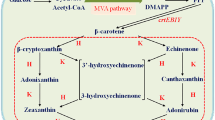Abstract
Blakeslea trispora is used commercially to produce β-carotene. Isopentenyl pyrophosphate isomerase (IPI) and geranylgeranyl pyrophosphate synthase (GGPS) are key enzymes in the biosynthesis of carotenoids. The cDNAs of genes ipi and carG were cloned from the fungus and expressed in Escherichia coli. Greater GGPS activity was needed in the engineered E. coli when IPP activity was increased. The introduction of GGPS and IPI increased the β-carotene content in E. coli from 0.5 to 0.95 mg/g dry wt.




Similar content being viewed by others
References
Anderson MS, Muehlbacher M, Street IP, Proffitt J, Poulter CD (1989) Isopentenyl diphosphate: dimethylallyl diphosphate isomerase. An improved purification of the enzyme and isolation of the gene from Saccharomyces cerevisiae. J Biol Chem 264:19169–19175
Bejarano ER, Cerdá-Olmedo E (1992) Independence of the carotene and sterol pathways of Phycomyces. FEBS Lett 306:209–212
Disch A, Rohmer M (1998) On the absence of the glyceraldehyde 3-phosphate/pyruvate pathway for isoprenoid biosynthesis in fungi and yeasts. FEMS Microbiol Lett 168:201–208
Homann V, Mende K, Arntz C, Ilardi V, Macino G, Morelli G, Bose G, Tudzynski B (1996) The isoprenoid pathway: cloning and characterization of fungal FPPS genes. Curr Genet 30:232–239
Jiang Y, Proteau P, Poulter D, Ferro-Novick S (1995) BTS1 encodes a geranylgeranyl diphosphate synthase in Saccharomyces cerevisiae. J Biol Chem 270:21793–21799
Kuzina V, Cerdá-Olmedo E (2007) Ubiquinone and carotene production in the Mucorales Blakeslea and Phycomyces. Appl Microbiol Biotechnol 76:991–999
Misawa N, Kajiwara S, Kondo K, Yokoyama A, Satomi Y, Saito T, Miki W, Ohtani T (1995) Canthaxanthin biosynthesis by the conversion of methylene to keto groups in a hydrocarbon beta-carotene by a single gene. Biochem Biophys Res Commun 209:867–876
Rodriguez-Saiz M, Paz B, De La Fuente JL, Lopez-Nieto MJ, Cabri W, Barredo JL (2004) Blakeslea trispora genes for carotene biosynthesis. Appl Environ Microbiol 70:5589–5594
Rohmer M, Knani M, Simonin P, Sutter B, Sahm H (1993) Isoprenoid biosynthesis in bacteria: a novel pathway for the early steps leading to isopentenyl diphosphate. Biochem J 295:517–524
Sandmann G, Misawa N, Wiedemann M, Vittorioso P, Carattoli A, Morelli G, Macino G (1993) Functional identification of al-3 from Neurospora crassa as the gene for geranylgeranyl pyrophosphate synthase by complementation with crt genes, in vitro characterization of the gene product and mutant analysis. J Photochem Photobiol, B 18:245–251
Steiger S, Sandmann G (2004) Cloning of two carotenoid ketolase genes from Nostoc punctiforme for the heterologous production of canthaxanthin and astaxanthin. Biotechnol Lett 26:813–817
Sun Z, Cunningham FX Jr, Gantt E (1998) Differential expression of two isopentenyl pyrophosphate isomerases and enhanced carotenoid accumulation in a unicellular chlorophyte. Proc Natl Acad Sci USA 95:11482–11488
Tamura K, Dudley J, Nei M, Kumar S (2007) MEGA4: molecular evolutionary genetics analysis (MEGA) software version 4.0. Mol Biol Evol 24:1596–1599
Tang Q, Li Y, Yuan QP (2008) Effects of an ergosterol synthesis inhibitor on gene transcription of terpenoid biosynthesis in Blakeslea trispora. Curr Microbiol 57:527–531
Acknowledgments
We thank Dr. Misawa (Ishikawa Prefectural University, Ishikawa, Japan) for providing plasmid pACCAR16ΔcrtX and Dr. Kawamukai (Shimane University, Matsue, Japan) for providing plasmid pACCAR25ΔcrtE. This work was supported in part by the grants from the National Natural Science Foundation of China (No. 20976009 and 21176018).
Author information
Authors and Affiliations
Corresponding author
Additional information
Jie Sun and Xin-Xiao Sun have contributed equally to this study.
Electronic supplementary material
Below is the link to the electronic supplementary material.
Rights and permissions
About this article
Cite this article
Sun, J., Sun, XX., Tang, PW. et al. Molecular cloning and functional expression of two key carotene synthetic genes derived from Blakeslea trispora into E. coli for increased β-carotene production. Biotechnol Lett 34, 2077–2082 (2012). https://doi.org/10.1007/s10529-012-1004-6
Received:
Accepted:
Published:
Issue Date:
DOI: https://doi.org/10.1007/s10529-012-1004-6




